CHTM38 Report: Critical Evaluation of Research Methods in Two Articles
VerifiedAdded on 2023/06/14
|20
|6152
|385
Report
AI Summary
This report critically evaluates the research methodologies employed in two journal articles: one focusing on gender perspectives in the hospitality industry and the other on the future of African air transport, specifically learning from Ethiopian Airlines. The analysis of the hospitality article examines the use of semi-structured interviews and the application of Risman's 'Gender as a Social Structure' model to understand barriers to women's advancement. The evaluation of the air transport article discusses the use of vector error correction and vector auto regression models to determine the causal relationship between air transport demand and economic development in Sub-Saharan African countries. The report identifies the strengths and limitations of each study's methodology, providing a comprehensive assessment of their approaches to data collection, analysis, and interpretation.
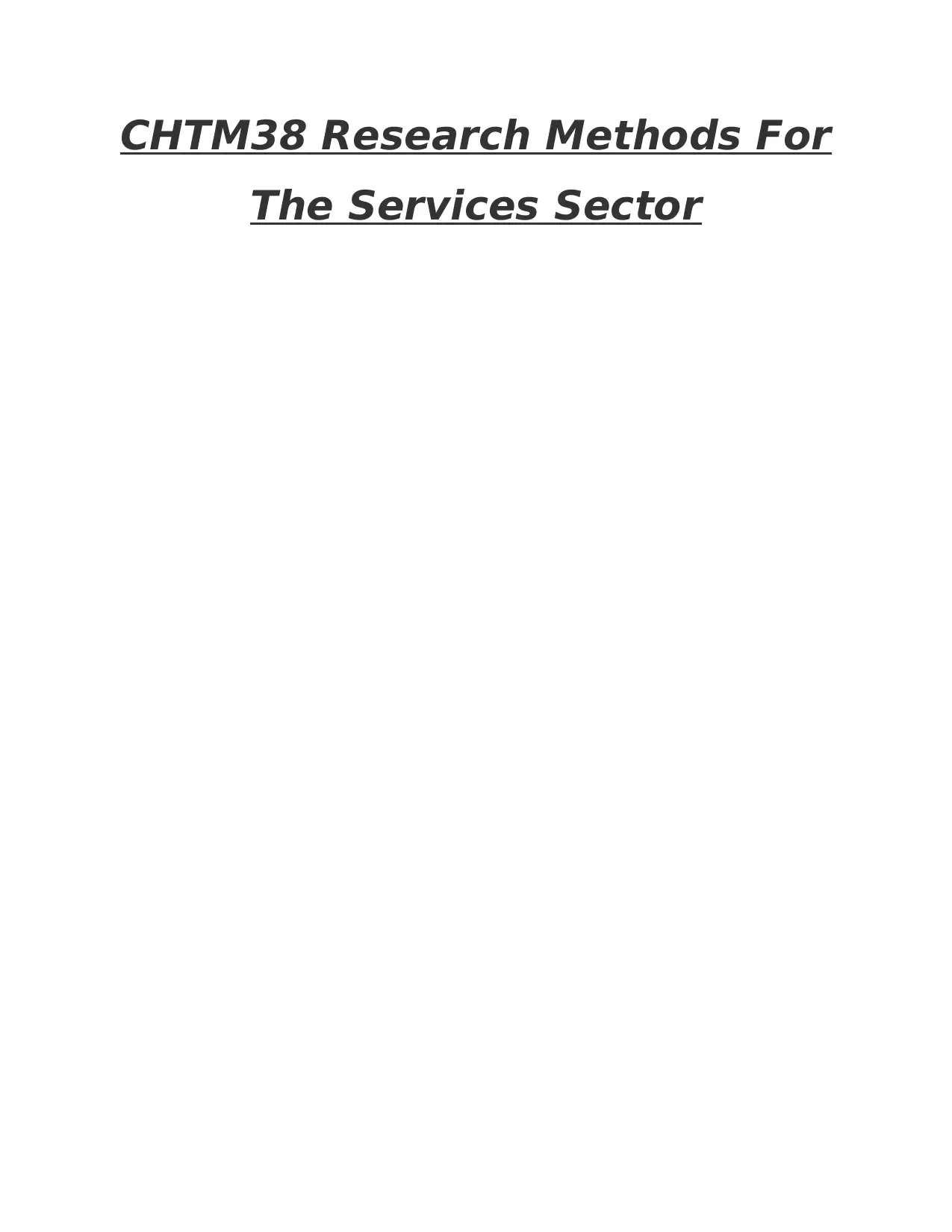
CHTM38 Research Methods For
The Services Sector
The Services Sector
Paraphrase This Document
Need a fresh take? Get an instant paraphrase of this document with our AI Paraphraser
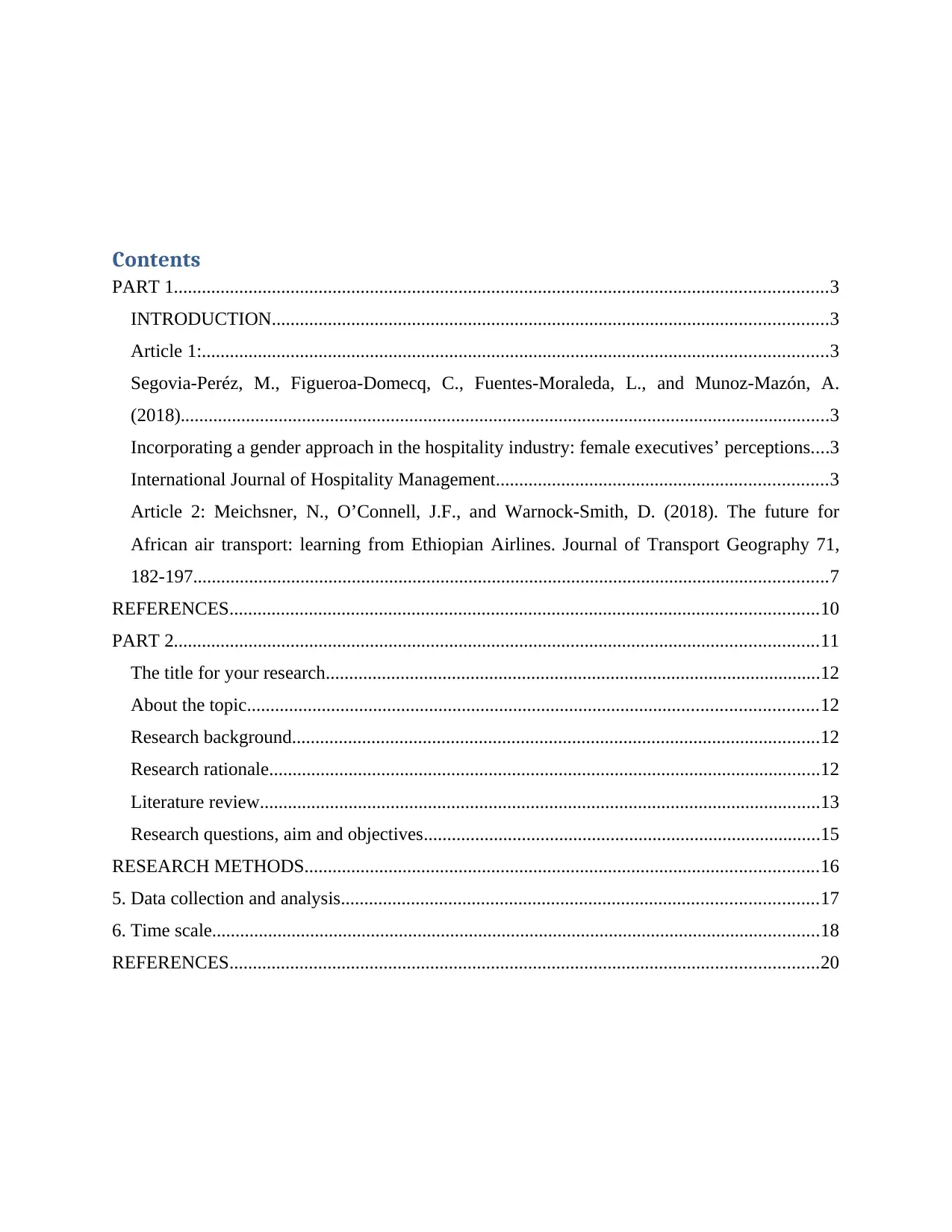
Contents
PART 1............................................................................................................................................3
INTRODUCTION.......................................................................................................................3
Article 1:......................................................................................................................................3
Segovia-Peréz, M., Figueroa-Domecq, C., Fuentes-Moraleda, L., and Munoz-Mazón, A.
(2018)...........................................................................................................................................3
Incorporating a gender approach in the hospitality industry: female executives’ perceptions....3
International Journal of Hospitality Management.......................................................................3
Article 2: Meichsner, N., O’Connell, J.F., and Warnock-Smith, D. (2018). The future for
African air transport: learning from Ethiopian Airlines. Journal of Transport Geography 71,
182-197........................................................................................................................................7
REFERENCES..............................................................................................................................10
PART 2..........................................................................................................................................11
The title for your research..........................................................................................................12
About the topic..........................................................................................................................12
Research background.................................................................................................................12
Research rationale......................................................................................................................12
Literature review........................................................................................................................13
Research questions, aim and objectives.....................................................................................15
RESEARCH METHODS..............................................................................................................16
5. Data collection and analysis......................................................................................................17
6. Time scale..................................................................................................................................18
REFERENCES..............................................................................................................................20
PART 1............................................................................................................................................3
INTRODUCTION.......................................................................................................................3
Article 1:......................................................................................................................................3
Segovia-Peréz, M., Figueroa-Domecq, C., Fuentes-Moraleda, L., and Munoz-Mazón, A.
(2018)...........................................................................................................................................3
Incorporating a gender approach in the hospitality industry: female executives’ perceptions....3
International Journal of Hospitality Management.......................................................................3
Article 2: Meichsner, N., O’Connell, J.F., and Warnock-Smith, D. (2018). The future for
African air transport: learning from Ethiopian Airlines. Journal of Transport Geography 71,
182-197........................................................................................................................................7
REFERENCES..............................................................................................................................10
PART 2..........................................................................................................................................11
The title for your research..........................................................................................................12
About the topic..........................................................................................................................12
Research background.................................................................................................................12
Research rationale......................................................................................................................12
Literature review........................................................................................................................13
Research questions, aim and objectives.....................................................................................15
RESEARCH METHODS..............................................................................................................16
5. Data collection and analysis......................................................................................................17
6. Time scale..................................................................................................................................18
REFERENCES..............................................................................................................................20
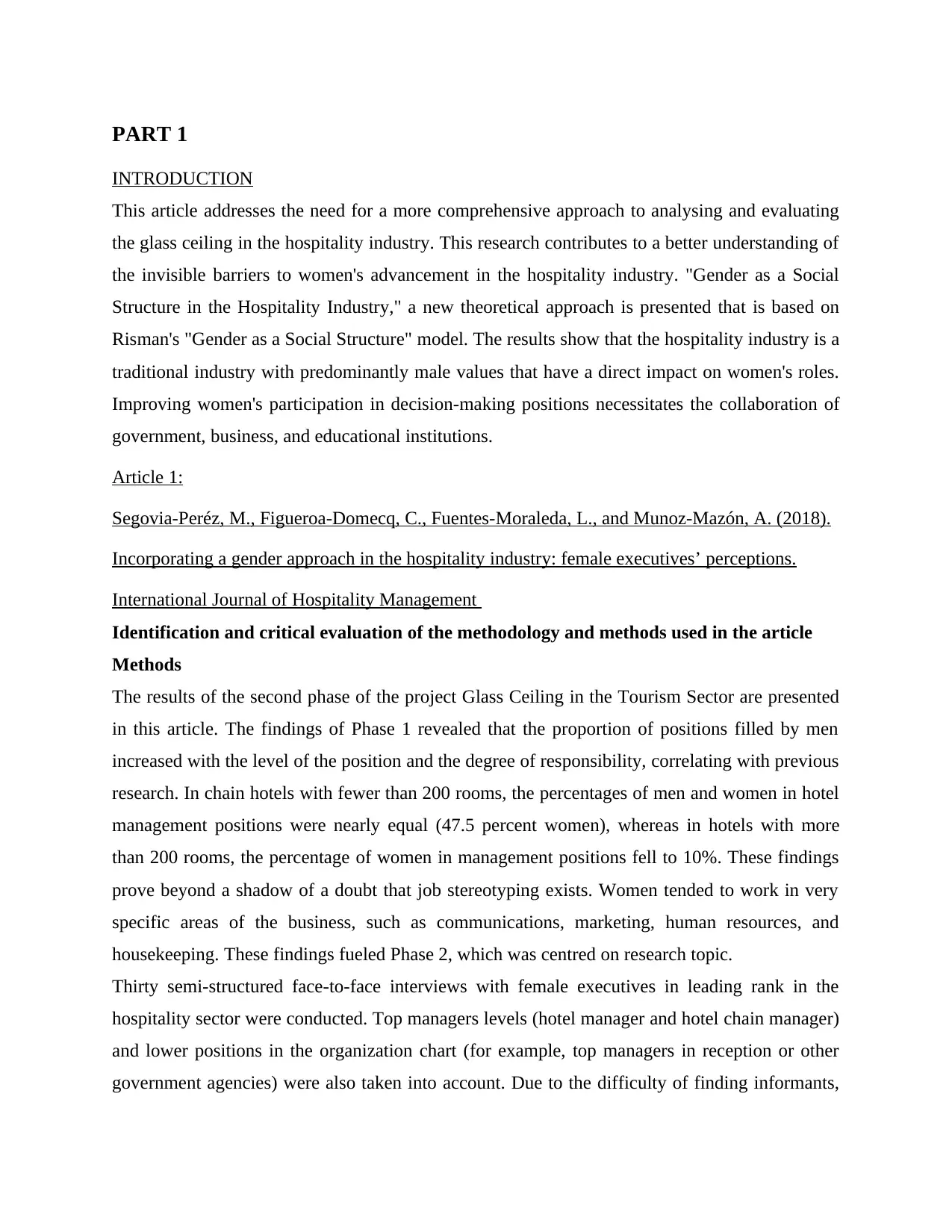
PART 1
INTRODUCTION
This article addresses the need for a more comprehensive approach to analysing and evaluating
the glass ceiling in the hospitality industry. This research contributes to a better understanding of
the invisible barriers to women's advancement in the hospitality industry. "Gender as a Social
Structure in the Hospitality Industry," a new theoretical approach is presented that is based on
Risman's "Gender as a Social Structure" model. The results show that the hospitality industry is a
traditional industry with predominantly male values that have a direct impact on women's roles.
Improving women's participation in decision-making positions necessitates the collaboration of
government, business, and educational institutions.
Article 1:
Segovia-Peréz, M., Figueroa-Domecq, C., Fuentes-Moraleda, L., and Munoz-Mazón, A. (2018).
Incorporating a gender approach in the hospitality industry: female executives’ perceptions.
International Journal of Hospitality Management
Identification and critical evaluation of the methodology and methods used in the article
Methods
The results of the second phase of the project Glass Ceiling in the Tourism Sector are presented
in this article. The findings of Phase 1 revealed that the proportion of positions filled by men
increased with the level of the position and the degree of responsibility, correlating with previous
research. In chain hotels with fewer than 200 rooms, the percentages of men and women in hotel
management positions were nearly equal (47.5 percent women), whereas in hotels with more
than 200 rooms, the percentage of women in management positions fell to 10%. These findings
prove beyond a shadow of a doubt that job stereotyping exists. Women tended to work in very
specific areas of the business, such as communications, marketing, human resources, and
housekeeping. These findings fueled Phase 2, which was centred on research topic.
Thirty semi-structured face-to-face interviews with female executives in leading rank in the
hospitality sector were conducted. Top managers levels (hotel manager and hotel chain manager)
and lower positions in the organization chart (for example, top managers in reception or other
government agencies) were also taken into account. Due to the difficulty of finding informants,
INTRODUCTION
This article addresses the need for a more comprehensive approach to analysing and evaluating
the glass ceiling in the hospitality industry. This research contributes to a better understanding of
the invisible barriers to women's advancement in the hospitality industry. "Gender as a Social
Structure in the Hospitality Industry," a new theoretical approach is presented that is based on
Risman's "Gender as a Social Structure" model. The results show that the hospitality industry is a
traditional industry with predominantly male values that have a direct impact on women's roles.
Improving women's participation in decision-making positions necessitates the collaboration of
government, business, and educational institutions.
Article 1:
Segovia-Peréz, M., Figueroa-Domecq, C., Fuentes-Moraleda, L., and Munoz-Mazón, A. (2018).
Incorporating a gender approach in the hospitality industry: female executives’ perceptions.
International Journal of Hospitality Management
Identification and critical evaluation of the methodology and methods used in the article
Methods
The results of the second phase of the project Glass Ceiling in the Tourism Sector are presented
in this article. The findings of Phase 1 revealed that the proportion of positions filled by men
increased with the level of the position and the degree of responsibility, correlating with previous
research. In chain hotels with fewer than 200 rooms, the percentages of men and women in hotel
management positions were nearly equal (47.5 percent women), whereas in hotels with more
than 200 rooms, the percentage of women in management positions fell to 10%. These findings
prove beyond a shadow of a doubt that job stereotyping exists. Women tended to work in very
specific areas of the business, such as communications, marketing, human resources, and
housekeeping. These findings fueled Phase 2, which was centred on research topic.
Thirty semi-structured face-to-face interviews with female executives in leading rank in the
hospitality sector were conducted. Top managers levels (hotel manager and hotel chain manager)
and lower positions in the organization chart (for example, top managers in reception or other
government agencies) were also taken into account. Due to the difficulty of finding informants,
⊘ This is a preview!⊘
Do you want full access?
Subscribe today to unlock all pages.

Trusted by 1+ million students worldwide
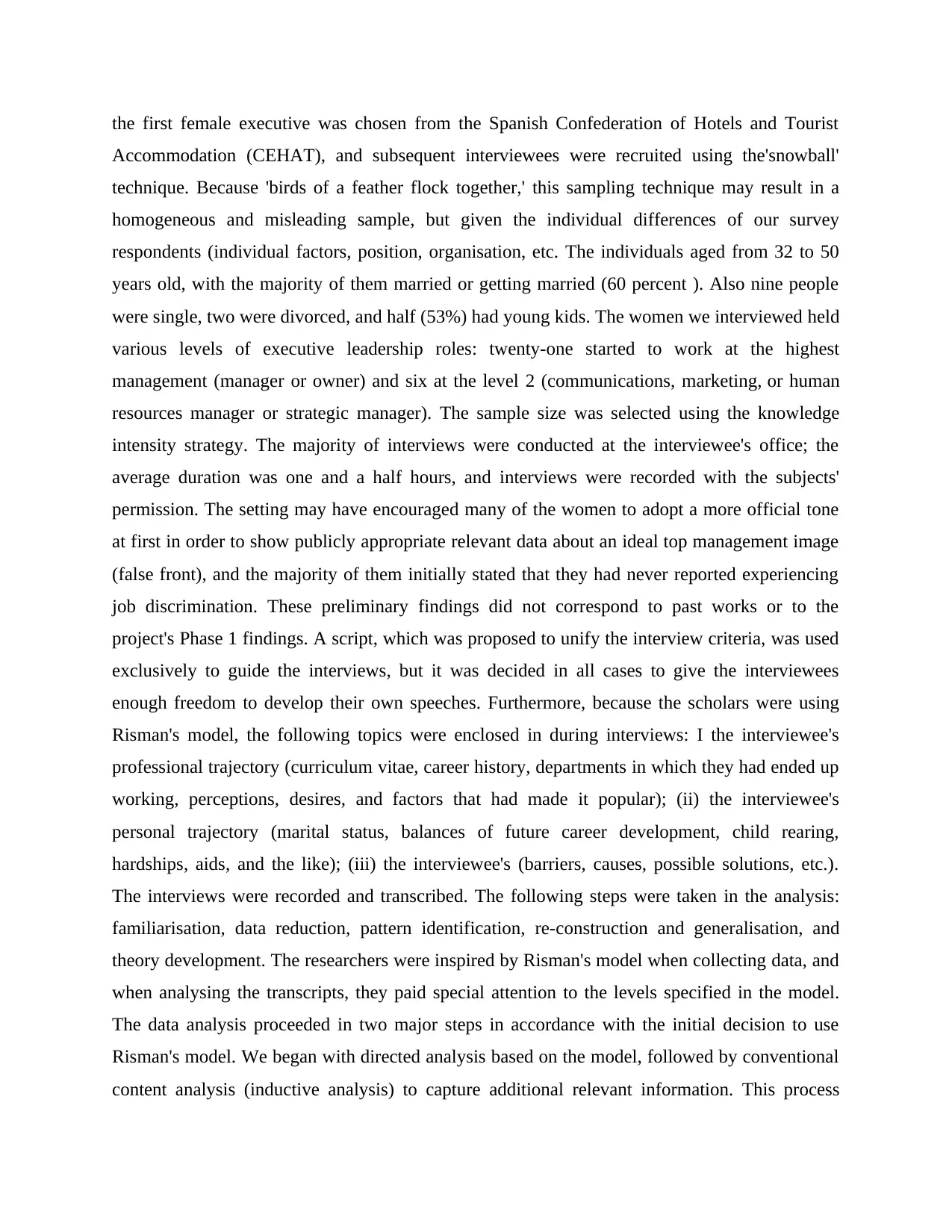
the first female executive was chosen from the Spanish Confederation of Hotels and Tourist
Accommodation (CEHAT), and subsequent interviewees were recruited using the'snowball'
technique. Because 'birds of a feather flock together,' this sampling technique may result in a
homogeneous and misleading sample, but given the individual differences of our survey
respondents (individual factors, position, organisation, etc. The individuals aged from 32 to 50
years old, with the majority of them married or getting married (60 percent ). Also nine people
were single, two were divorced, and half (53%) had young kids. The women we interviewed held
various levels of executive leadership roles: twenty-one started to work at the highest
management (manager or owner) and six at the level 2 (communications, marketing, or human
resources manager or strategic manager). The sample size was selected using the knowledge
intensity strategy. The majority of interviews were conducted at the interviewee's office; the
average duration was one and a half hours, and interviews were recorded with the subjects'
permission. The setting may have encouraged many of the women to adopt a more official tone
at first in order to show publicly appropriate relevant data about an ideal top management image
(false front), and the majority of them initially stated that they had never reported experiencing
job discrimination. These preliminary findings did not correspond to past works or to the
project's Phase 1 findings. A script, which was proposed to unify the interview criteria, was used
exclusively to guide the interviews, but it was decided in all cases to give the interviewees
enough freedom to develop their own speeches. Furthermore, because the scholars were using
Risman's model, the following topics were enclosed in during interviews: I the interviewee's
professional trajectory (curriculum vitae, career history, departments in which they had ended up
working, perceptions, desires, and factors that had made it popular); (ii) the interviewee's
personal trajectory (marital status, balances of future career development, child rearing,
hardships, aids, and the like); (iii) the interviewee's (barriers, causes, possible solutions, etc.).
The interviews were recorded and transcribed. The following steps were taken in the analysis:
familiarisation, data reduction, pattern identification, re-construction and generalisation, and
theory development. The researchers were inspired by Risman's model when collecting data, and
when analysing the transcripts, they paid special attention to the levels specified in the model.
The data analysis proceeded in two major steps in accordance with the initial decision to use
Risman's model. We began with directed analysis based on the model, followed by conventional
content analysis (inductive analysis) to capture additional relevant information. This process
Accommodation (CEHAT), and subsequent interviewees were recruited using the'snowball'
technique. Because 'birds of a feather flock together,' this sampling technique may result in a
homogeneous and misleading sample, but given the individual differences of our survey
respondents (individual factors, position, organisation, etc. The individuals aged from 32 to 50
years old, with the majority of them married or getting married (60 percent ). Also nine people
were single, two were divorced, and half (53%) had young kids. The women we interviewed held
various levels of executive leadership roles: twenty-one started to work at the highest
management (manager or owner) and six at the level 2 (communications, marketing, or human
resources manager or strategic manager). The sample size was selected using the knowledge
intensity strategy. The majority of interviews were conducted at the interviewee's office; the
average duration was one and a half hours, and interviews were recorded with the subjects'
permission. The setting may have encouraged many of the women to adopt a more official tone
at first in order to show publicly appropriate relevant data about an ideal top management image
(false front), and the majority of them initially stated that they had never reported experiencing
job discrimination. These preliminary findings did not correspond to past works or to the
project's Phase 1 findings. A script, which was proposed to unify the interview criteria, was used
exclusively to guide the interviews, but it was decided in all cases to give the interviewees
enough freedom to develop their own speeches. Furthermore, because the scholars were using
Risman's model, the following topics were enclosed in during interviews: I the interviewee's
professional trajectory (curriculum vitae, career history, departments in which they had ended up
working, perceptions, desires, and factors that had made it popular); (ii) the interviewee's
personal trajectory (marital status, balances of future career development, child rearing,
hardships, aids, and the like); (iii) the interviewee's (barriers, causes, possible solutions, etc.).
The interviews were recorded and transcribed. The following steps were taken in the analysis:
familiarisation, data reduction, pattern identification, re-construction and generalisation, and
theory development. The researchers were inspired by Risman's model when collecting data, and
when analysing the transcripts, they paid special attention to the levels specified in the model.
The data analysis proceeded in two major steps in accordance with the initial decision to use
Risman's model. We began with directed analysis based on the model, followed by conventional
content analysis (inductive analysis) to capture additional relevant information. This process
Paraphrase This Document
Need a fresh take? Get an instant paraphrase of this document with our AI Paraphraser
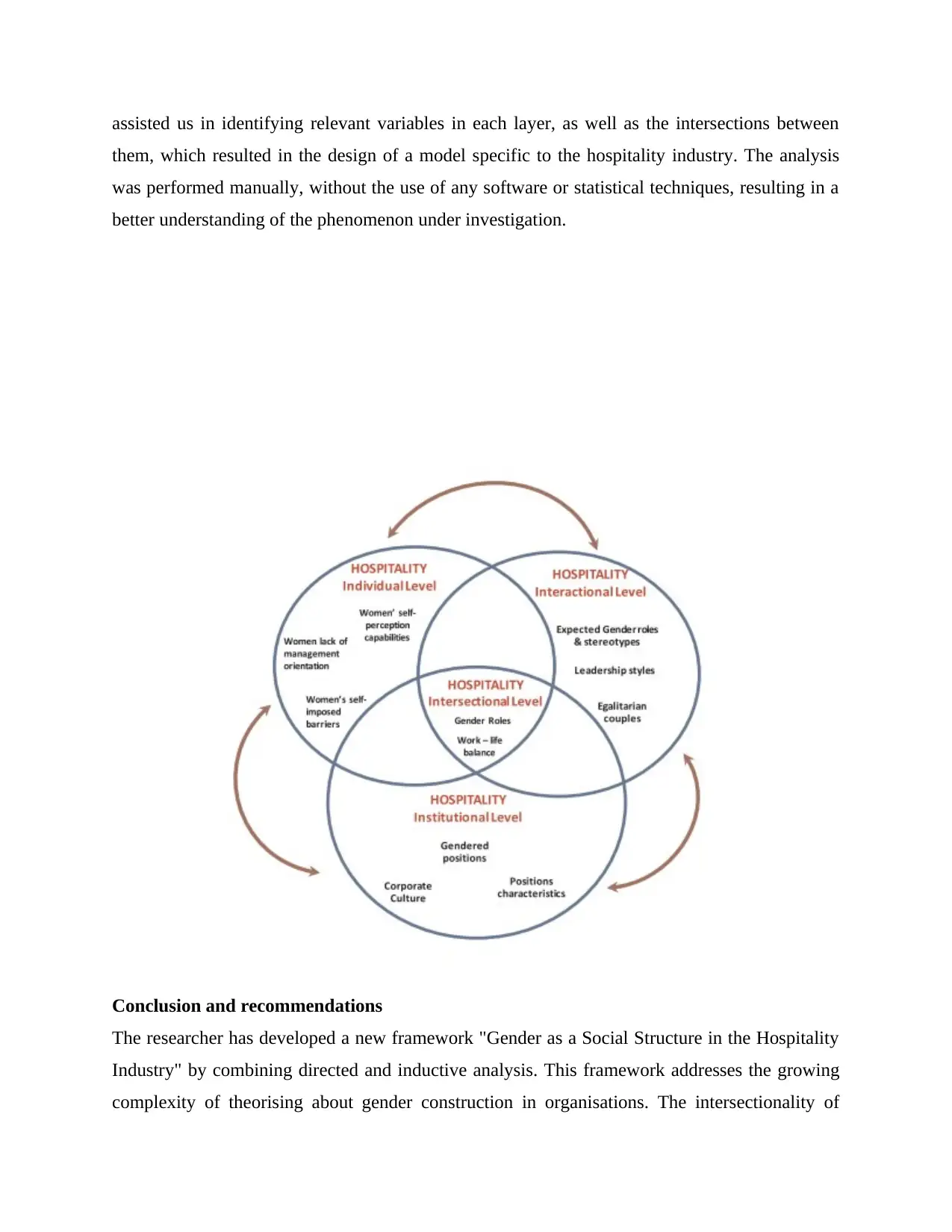
assisted us in identifying relevant variables in each layer, as well as the intersections between
them, which resulted in the design of a model specific to the hospitality industry. The analysis
was performed manually, without the use of any software or statistical techniques, resulting in a
better understanding of the phenomenon under investigation.
Conclusion and recommendations
The researcher has developed a new framework "Gender as a Social Structure in the Hospitality
Industry" by combining directed and inductive analysis. This framework addresses the growing
complexity of theorising about gender construction in organisations. The intersectionality of
them, which resulted in the design of a model specific to the hospitality industry. The analysis
was performed manually, without the use of any software or statistical techniques, resulting in a
better understanding of the phenomenon under investigation.
Conclusion and recommendations
The researcher has developed a new framework "Gender as a Social Structure in the Hospitality
Industry" by combining directed and inductive analysis. This framework addresses the growing
complexity of theorising about gender construction in organisations. The intersectionality of
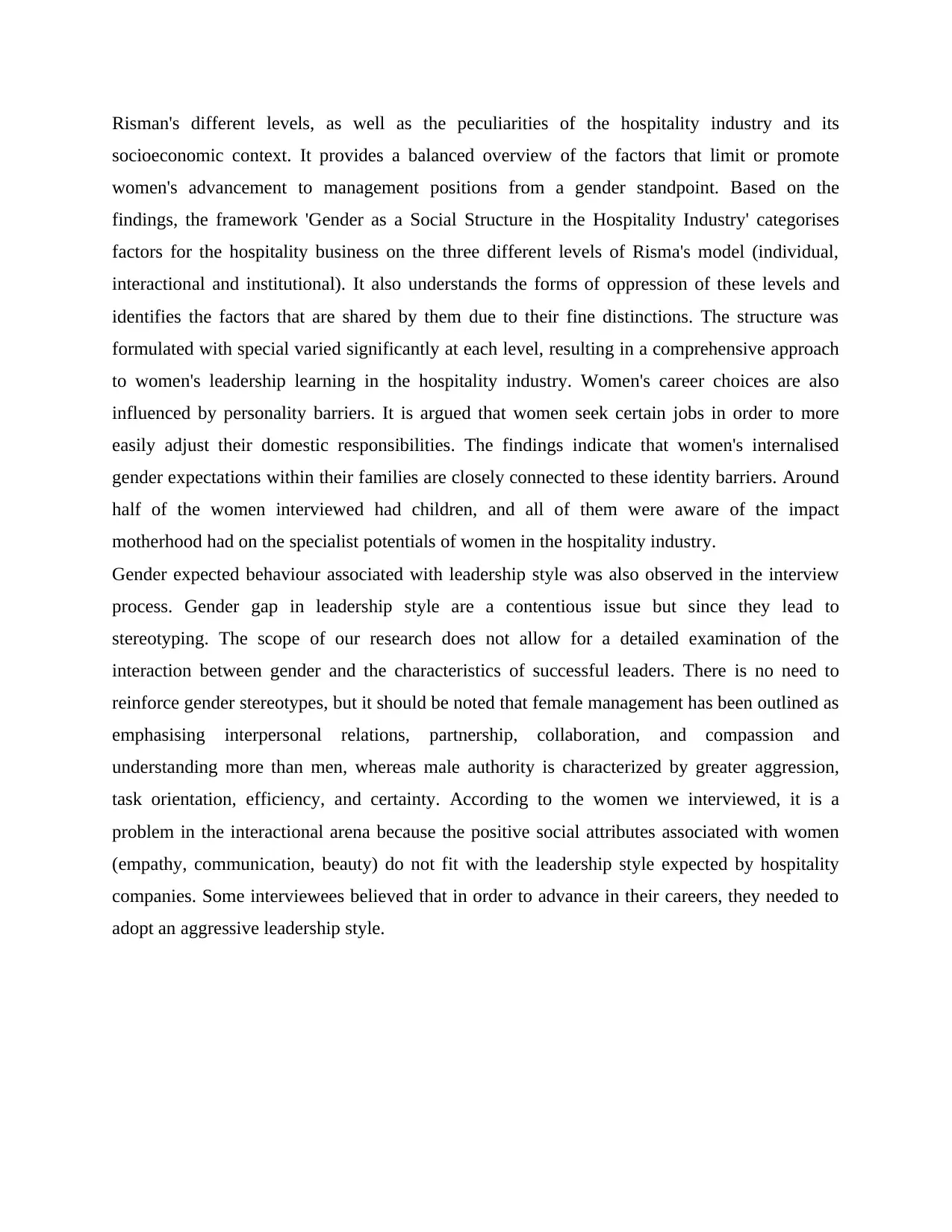
Risman's different levels, as well as the peculiarities of the hospitality industry and its
socioeconomic context. It provides a balanced overview of the factors that limit or promote
women's advancement to management positions from a gender standpoint. Based on the
findings, the framework 'Gender as a Social Structure in the Hospitality Industry' categorises
factors for the hospitality business on the three different levels of Risma's model (individual,
interactional and institutional). It also understands the forms of oppression of these levels and
identifies the factors that are shared by them due to their fine distinctions. The structure was
formulated with special varied significantly at each level, resulting in a comprehensive approach
to women's leadership learning in the hospitality industry. Women's career choices are also
influenced by personality barriers. It is argued that women seek certain jobs in order to more
easily adjust their domestic responsibilities. The findings indicate that women's internalised
gender expectations within their families are closely connected to these identity barriers. Around
half of the women interviewed had children, and all of them were aware of the impact
motherhood had on the specialist potentials of women in the hospitality industry.
Gender expected behaviour associated with leadership style was also observed in the interview
process. Gender gap in leadership style are a contentious issue but since they lead to
stereotyping. The scope of our research does not allow for a detailed examination of the
interaction between gender and the characteristics of successful leaders. There is no need to
reinforce gender stereotypes, but it should be noted that female management has been outlined as
emphasising interpersonal relations, partnership, collaboration, and compassion and
understanding more than men, whereas male authority is characterized by greater aggression,
task orientation, efficiency, and certainty. According to the women we interviewed, it is a
problem in the interactional arena because the positive social attributes associated with women
(empathy, communication, beauty) do not fit with the leadership style expected by hospitality
companies. Some interviewees believed that in order to advance in their careers, they needed to
adopt an aggressive leadership style.
socioeconomic context. It provides a balanced overview of the factors that limit or promote
women's advancement to management positions from a gender standpoint. Based on the
findings, the framework 'Gender as a Social Structure in the Hospitality Industry' categorises
factors for the hospitality business on the three different levels of Risma's model (individual,
interactional and institutional). It also understands the forms of oppression of these levels and
identifies the factors that are shared by them due to their fine distinctions. The structure was
formulated with special varied significantly at each level, resulting in a comprehensive approach
to women's leadership learning in the hospitality industry. Women's career choices are also
influenced by personality barriers. It is argued that women seek certain jobs in order to more
easily adjust their domestic responsibilities. The findings indicate that women's internalised
gender expectations within their families are closely connected to these identity barriers. Around
half of the women interviewed had children, and all of them were aware of the impact
motherhood had on the specialist potentials of women in the hospitality industry.
Gender expected behaviour associated with leadership style was also observed in the interview
process. Gender gap in leadership style are a contentious issue but since they lead to
stereotyping. The scope of our research does not allow for a detailed examination of the
interaction between gender and the characteristics of successful leaders. There is no need to
reinforce gender stereotypes, but it should be noted that female management has been outlined as
emphasising interpersonal relations, partnership, collaboration, and compassion and
understanding more than men, whereas male authority is characterized by greater aggression,
task orientation, efficiency, and certainty. According to the women we interviewed, it is a
problem in the interactional arena because the positive social attributes associated with women
(empathy, communication, beauty) do not fit with the leadership style expected by hospitality
companies. Some interviewees believed that in order to advance in their careers, they needed to
adopt an aggressive leadership style.
⊘ This is a preview!⊘
Do you want full access?
Subscribe today to unlock all pages.

Trusted by 1+ million students worldwide
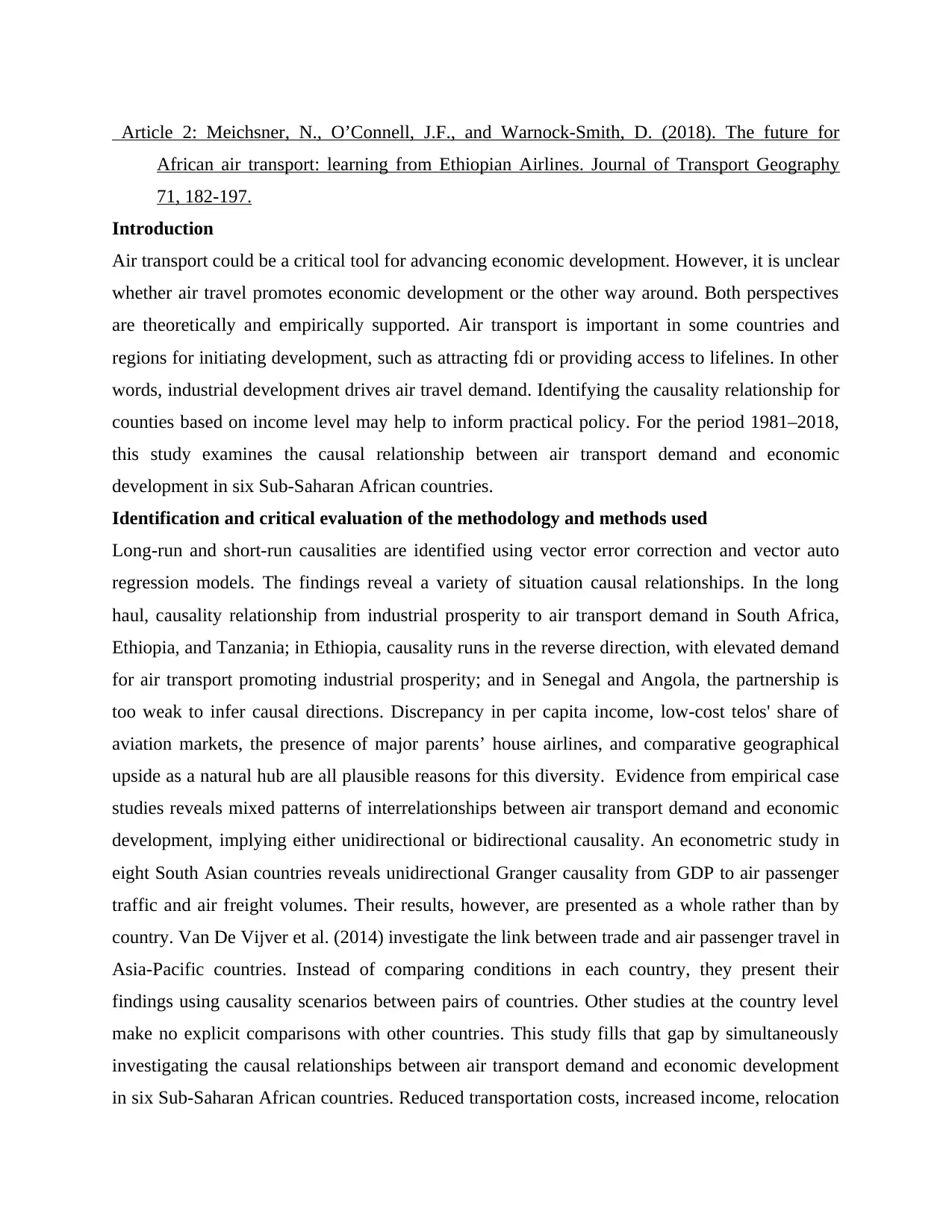
Article 2: Meichsner, N., O’Connell, J.F., and Warnock-Smith, D. (2018). The future for
African air transport: learning from Ethiopian Airlines. Journal of Transport Geography
71, 182-197.
Introduction
Air transport could be a critical tool for advancing economic development. However, it is unclear
whether air travel promotes economic development or the other way around. Both perspectives
are theoretically and empirically supported. Air transport is important in some countries and
regions for initiating development, such as attracting fdi or providing access to lifelines. In other
words, industrial development drives air travel demand. Identifying the causality relationship for
counties based on income level may help to inform practical policy. For the period 1981–2018,
this study examines the causal relationship between air transport demand and economic
development in six Sub-Saharan African countries.
Identification and critical evaluation of the methodology and methods used
Long-run and short-run causalities are identified using vector error correction and vector auto
regression models. The findings reveal a variety of situation causal relationships. In the long
haul, causality relationship from industrial prosperity to air transport demand in South Africa,
Ethiopia, and Tanzania; in Ethiopia, causality runs in the reverse direction, with elevated demand
for air transport promoting industrial prosperity; and in Senegal and Angola, the partnership is
too weak to infer causal directions. Discrepancy in per capita income, low-cost telos' share of
aviation markets, the presence of major parents’ house airlines, and comparative geographical
upside as a natural hub are all plausible reasons for this diversity. Evidence from empirical case
studies reveals mixed patterns of interrelationships between air transport demand and economic
development, implying either unidirectional or bidirectional causality. An econometric study in
eight South Asian countries reveals unidirectional Granger causality from GDP to air passenger
traffic and air freight volumes. Their results, however, are presented as a whole rather than by
country. Van De Vijver et al. (2014) investigate the link between trade and air passenger travel in
Asia-Pacific countries. Instead of comparing conditions in each country, they present their
findings using causality scenarios between pairs of countries. Other studies at the country level
make no explicit comparisons with other countries. This study fills that gap by simultaneously
investigating the causal relationships between air transport demand and economic development
in six Sub-Saharan African countries. Reduced transportation costs, increased income, relocation
African air transport: learning from Ethiopian Airlines. Journal of Transport Geography
71, 182-197.
Introduction
Air transport could be a critical tool for advancing economic development. However, it is unclear
whether air travel promotes economic development or the other way around. Both perspectives
are theoretically and empirically supported. Air transport is important in some countries and
regions for initiating development, such as attracting fdi or providing access to lifelines. In other
words, industrial development drives air travel demand. Identifying the causality relationship for
counties based on income level may help to inform practical policy. For the period 1981–2018,
this study examines the causal relationship between air transport demand and economic
development in six Sub-Saharan African countries.
Identification and critical evaluation of the methodology and methods used
Long-run and short-run causalities are identified using vector error correction and vector auto
regression models. The findings reveal a variety of situation causal relationships. In the long
haul, causality relationship from industrial prosperity to air transport demand in South Africa,
Ethiopia, and Tanzania; in Ethiopia, causality runs in the reverse direction, with elevated demand
for air transport promoting industrial prosperity; and in Senegal and Angola, the partnership is
too weak to infer causal directions. Discrepancy in per capita income, low-cost telos' share of
aviation markets, the presence of major parents’ house airlines, and comparative geographical
upside as a natural hub are all plausible reasons for this diversity. Evidence from empirical case
studies reveals mixed patterns of interrelationships between air transport demand and economic
development, implying either unidirectional or bidirectional causality. An econometric study in
eight South Asian countries reveals unidirectional Granger causality from GDP to air passenger
traffic and air freight volumes. Their results, however, are presented as a whole rather than by
country. Van De Vijver et al. (2014) investigate the link between trade and air passenger travel in
Asia-Pacific countries. Instead of comparing conditions in each country, they present their
findings using causality scenarios between pairs of countries. Other studies at the country level
make no explicit comparisons with other countries. This study fills that gap by simultaneously
investigating the causal relationships between air transport demand and economic development
in six Sub-Saharan African countries. Reduced transportation costs, increased income, relocation
Paraphrase This Document
Need a fresh take? Get an instant paraphrase of this document with our AI Paraphraser
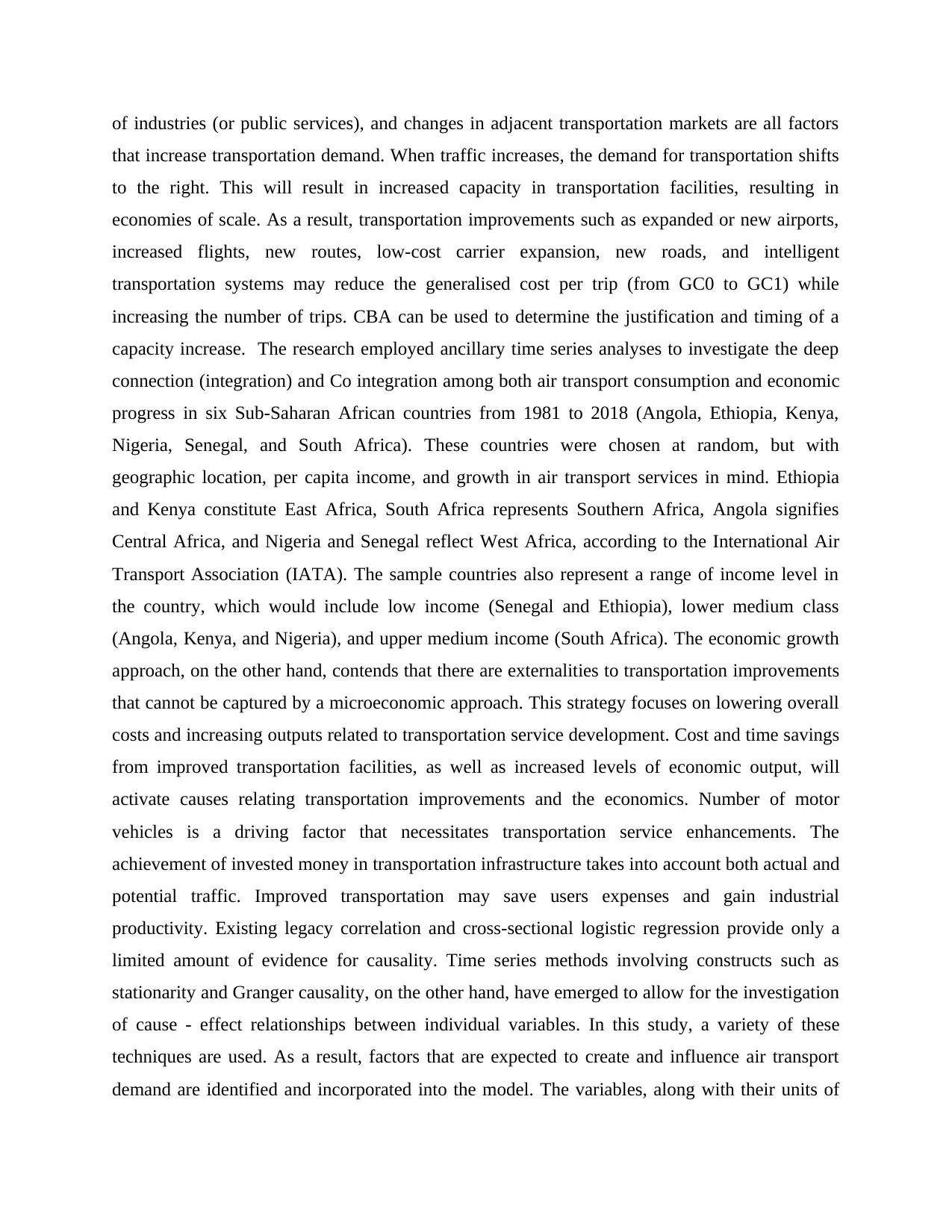
of industries (or public services), and changes in adjacent transportation markets are all factors
that increase transportation demand. When traffic increases, the demand for transportation shifts
to the right. This will result in increased capacity in transportation facilities, resulting in
economies of scale. As a result, transportation improvements such as expanded or new airports,
increased flights, new routes, low-cost carrier expansion, new roads, and intelligent
transportation systems may reduce the generalised cost per trip (from GC0 to GC1) while
increasing the number of trips. CBA can be used to determine the justification and timing of a
capacity increase. The research employed ancillary time series analyses to investigate the deep
connection (integration) and Co integration among both air transport consumption and economic
progress in six Sub-Saharan African countries from 1981 to 2018 (Angola, Ethiopia, Kenya,
Nigeria, Senegal, and South Africa). These countries were chosen at random, but with
geographic location, per capita income, and growth in air transport services in mind. Ethiopia
and Kenya constitute East Africa, South Africa represents Southern Africa, Angola signifies
Central Africa, and Nigeria and Senegal reflect West Africa, according to the International Air
Transport Association (IATA). The sample countries also represent a range of income level in
the country, which would include low income (Senegal and Ethiopia), lower medium class
(Angola, Kenya, and Nigeria), and upper medium income (South Africa). The economic growth
approach, on the other hand, contends that there are externalities to transportation improvements
that cannot be captured by a microeconomic approach. This strategy focuses on lowering overall
costs and increasing outputs related to transportation service development. Cost and time savings
from improved transportation facilities, as well as increased levels of economic output, will
activate causes relating transportation improvements and the economics. Number of motor
vehicles is a driving factor that necessitates transportation service enhancements. The
achievement of invested money in transportation infrastructure takes into account both actual and
potential traffic. Improved transportation may save users expenses and gain industrial
productivity. Existing legacy correlation and cross-sectional logistic regression provide only a
limited amount of evidence for causality. Time series methods involving constructs such as
stationarity and Granger causality, on the other hand, have emerged to allow for the investigation
of cause - effect relationships between individual variables. In this study, a variety of these
techniques are used. As a result, factors that are expected to create and influence air transport
demand are identified and incorporated into the model. The variables, along with their units of
that increase transportation demand. When traffic increases, the demand for transportation shifts
to the right. This will result in increased capacity in transportation facilities, resulting in
economies of scale. As a result, transportation improvements such as expanded or new airports,
increased flights, new routes, low-cost carrier expansion, new roads, and intelligent
transportation systems may reduce the generalised cost per trip (from GC0 to GC1) while
increasing the number of trips. CBA can be used to determine the justification and timing of a
capacity increase. The research employed ancillary time series analyses to investigate the deep
connection (integration) and Co integration among both air transport consumption and economic
progress in six Sub-Saharan African countries from 1981 to 2018 (Angola, Ethiopia, Kenya,
Nigeria, Senegal, and South Africa). These countries were chosen at random, but with
geographic location, per capita income, and growth in air transport services in mind. Ethiopia
and Kenya constitute East Africa, South Africa represents Southern Africa, Angola signifies
Central Africa, and Nigeria and Senegal reflect West Africa, according to the International Air
Transport Association (IATA). The sample countries also represent a range of income level in
the country, which would include low income (Senegal and Ethiopia), lower medium class
(Angola, Kenya, and Nigeria), and upper medium income (South Africa). The economic growth
approach, on the other hand, contends that there are externalities to transportation improvements
that cannot be captured by a microeconomic approach. This strategy focuses on lowering overall
costs and increasing outputs related to transportation service development. Cost and time savings
from improved transportation facilities, as well as increased levels of economic output, will
activate causes relating transportation improvements and the economics. Number of motor
vehicles is a driving factor that necessitates transportation service enhancements. The
achievement of invested money in transportation infrastructure takes into account both actual and
potential traffic. Improved transportation may save users expenses and gain industrial
productivity. Existing legacy correlation and cross-sectional logistic regression provide only a
limited amount of evidence for causality. Time series methods involving constructs such as
stationarity and Granger causality, on the other hand, have emerged to allow for the investigation
of cause - effect relationships between individual variables. In this study, a variety of these
techniques are used. As a result, factors that are expected to create and influence air transport
demand are identified and incorporated into the model. The variables, along with their units of
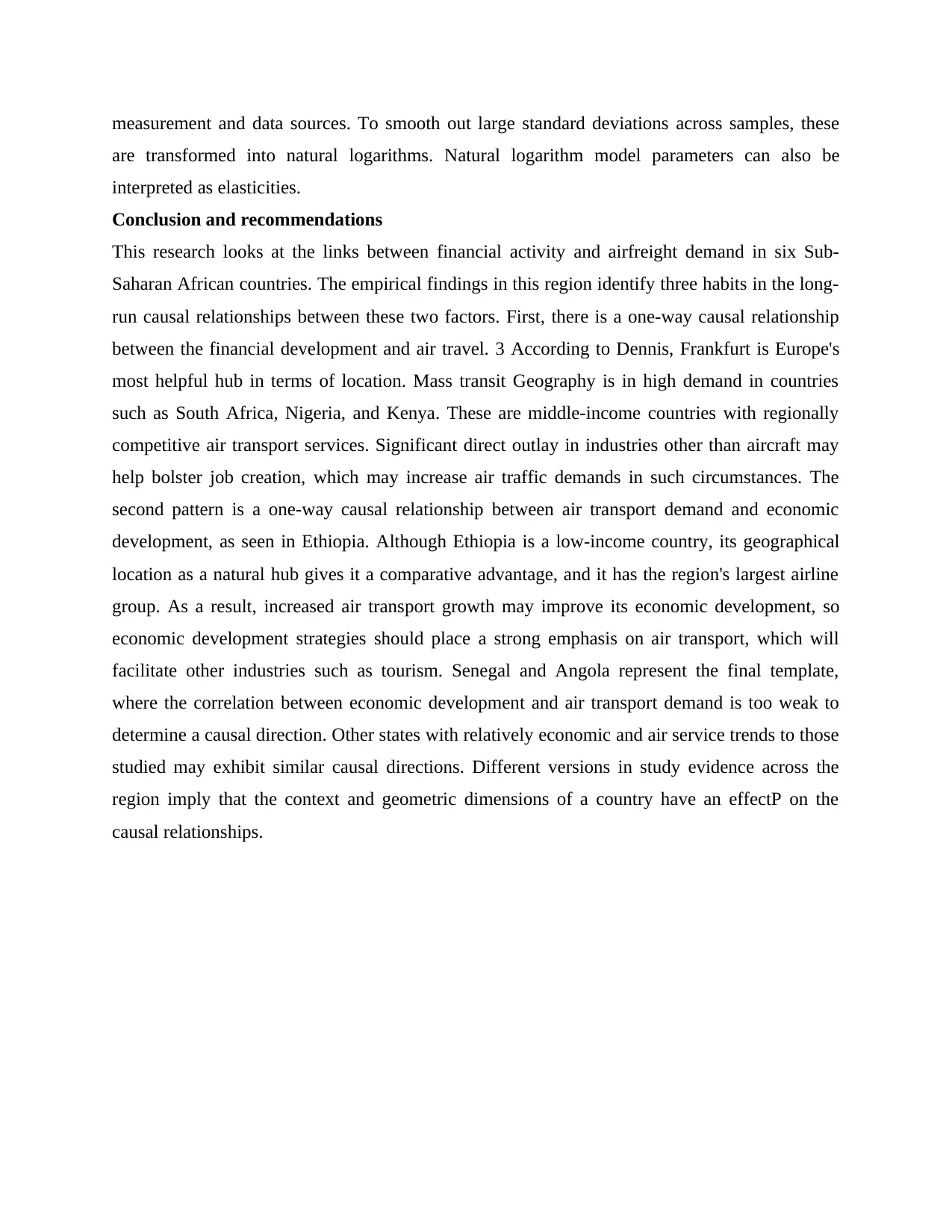
measurement and data sources. To smooth out large standard deviations across samples, these
are transformed into natural logarithms. Natural logarithm model parameters can also be
interpreted as elasticities.
Conclusion and recommendations
This research looks at the links between financial activity and airfreight demand in six Sub-
Saharan African countries. The empirical findings in this region identify three habits in the long-
run causal relationships between these two factors. First, there is a one-way causal relationship
between the financial development and air travel. 3 According to Dennis, Frankfurt is Europe's
most helpful hub in terms of location. Mass transit Geography is in high demand in countries
such as South Africa, Nigeria, and Kenya. These are middle-income countries with regionally
competitive air transport services. Significant direct outlay in industries other than aircraft may
help bolster job creation, which may increase air traffic demands in such circumstances. The
second pattern is a one-way causal relationship between air transport demand and economic
development, as seen in Ethiopia. Although Ethiopia is a low-income country, its geographical
location as a natural hub gives it a comparative advantage, and it has the region's largest airline
group. As a result, increased air transport growth may improve its economic development, so
economic development strategies should place a strong emphasis on air transport, which will
facilitate other industries such as tourism. Senegal and Angola represent the final template,
where the correlation between economic development and air transport demand is too weak to
determine a causal direction. Other states with relatively economic and air service trends to those
studied may exhibit similar causal directions. Different versions in study evidence across the
region imply that the context and geometric dimensions of a country have an effectP on the
causal relationships.
are transformed into natural logarithms. Natural logarithm model parameters can also be
interpreted as elasticities.
Conclusion and recommendations
This research looks at the links between financial activity and airfreight demand in six Sub-
Saharan African countries. The empirical findings in this region identify three habits in the long-
run causal relationships between these two factors. First, there is a one-way causal relationship
between the financial development and air travel. 3 According to Dennis, Frankfurt is Europe's
most helpful hub in terms of location. Mass transit Geography is in high demand in countries
such as South Africa, Nigeria, and Kenya. These are middle-income countries with regionally
competitive air transport services. Significant direct outlay in industries other than aircraft may
help bolster job creation, which may increase air traffic demands in such circumstances. The
second pattern is a one-way causal relationship between air transport demand and economic
development, as seen in Ethiopia. Although Ethiopia is a low-income country, its geographical
location as a natural hub gives it a comparative advantage, and it has the region's largest airline
group. As a result, increased air transport growth may improve its economic development, so
economic development strategies should place a strong emphasis on air transport, which will
facilitate other industries such as tourism. Senegal and Angola represent the final template,
where the correlation between economic development and air transport demand is too weak to
determine a causal direction. Other states with relatively economic and air service trends to those
studied may exhibit similar causal directions. Different versions in study evidence across the
region imply that the context and geometric dimensions of a country have an effectP on the
causal relationships.
⊘ This is a preview!⊘
Do you want full access?
Subscribe today to unlock all pages.

Trusted by 1+ million students worldwide
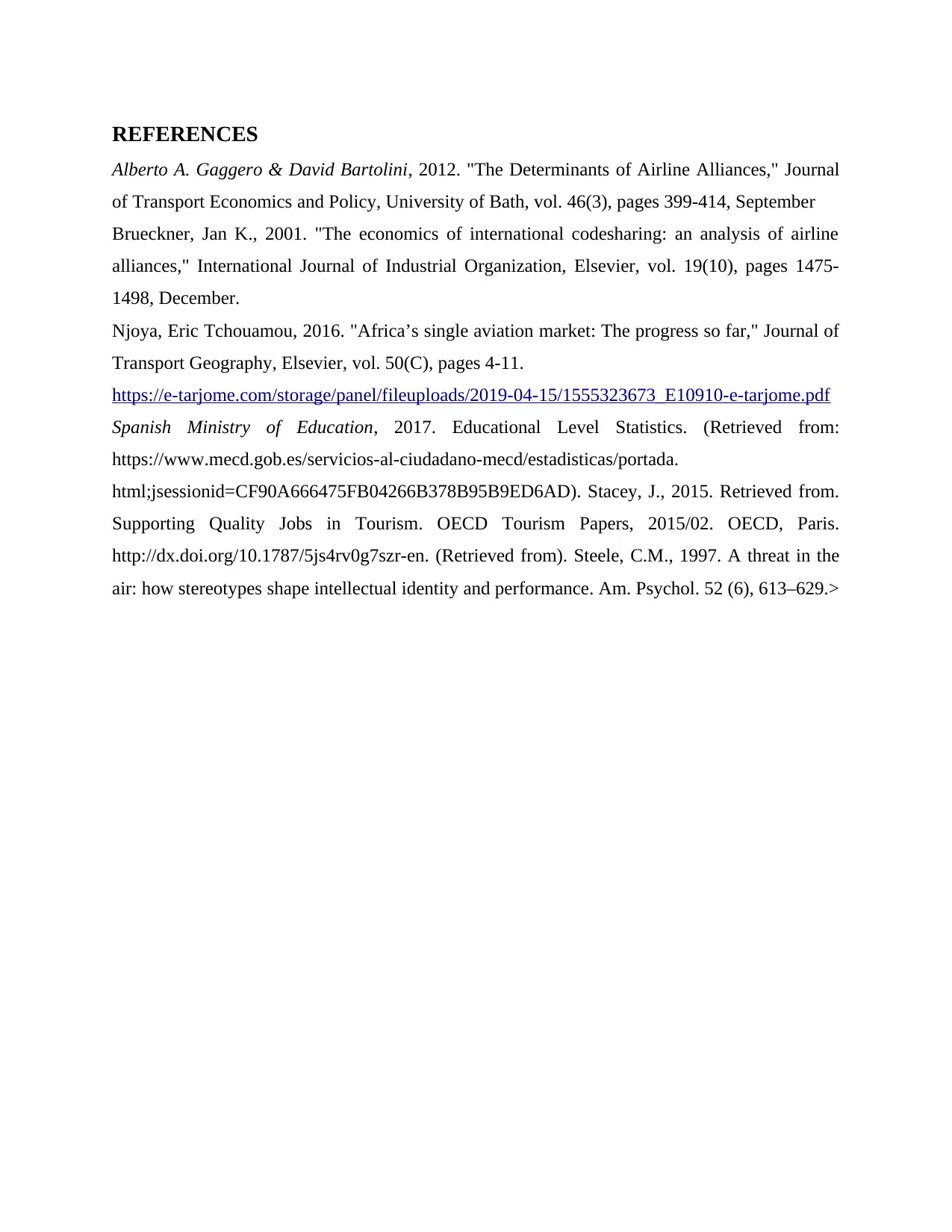
REFERENCES
Alberto A. Gaggero & David Bartolini, 2012. "The Determinants of Airline Alliances," Journal
of Transport Economics and Policy, University of Bath, vol. 46(3), pages 399-414, September
Brueckner, Jan K., 2001. "The economics of international codesharing: an analysis of airline
alliances," International Journal of Industrial Organization, Elsevier, vol. 19(10), pages 1475-
1498, December.
Njoya, Eric Tchouamou, 2016. "Africa’s single aviation market: The progress so far," Journal of
Transport Geography, Elsevier, vol. 50(C), pages 4-11.
https://e-tarjome.com/storage/panel/fileuploads/2019-04-15/1555323673_E10910-e-tarjome.pdf
Spanish Ministry of Education, 2017. Educational Level Statistics. (Retrieved from:
https://www.mecd.gob.es/servicios-al-ciudadano-mecd/estadisticas/portada.
html;jsessionid=CF90A666475FB04266B378B95B9ED6AD). Stacey, J., 2015. Retrieved from.
Supporting Quality Jobs in Tourism. OECD Tourism Papers, 2015/02. OECD, Paris.
http://dx.doi.org/10.1787/5js4rv0g7szr-en. (Retrieved from). Steele, C.M., 1997. A threat in the
air: how stereotypes shape intellectual identity and performance. Am. Psychol. 52 (6), 613–629.>
Alberto A. Gaggero & David Bartolini, 2012. "The Determinants of Airline Alliances," Journal
of Transport Economics and Policy, University of Bath, vol. 46(3), pages 399-414, September
Brueckner, Jan K., 2001. "The economics of international codesharing: an analysis of airline
alliances," International Journal of Industrial Organization, Elsevier, vol. 19(10), pages 1475-
1498, December.
Njoya, Eric Tchouamou, 2016. "Africa’s single aviation market: The progress so far," Journal of
Transport Geography, Elsevier, vol. 50(C), pages 4-11.
https://e-tarjome.com/storage/panel/fileuploads/2019-04-15/1555323673_E10910-e-tarjome.pdf
Spanish Ministry of Education, 2017. Educational Level Statistics. (Retrieved from:
https://www.mecd.gob.es/servicios-al-ciudadano-mecd/estadisticas/portada.
html;jsessionid=CF90A666475FB04266B378B95B9ED6AD). Stacey, J., 2015. Retrieved from.
Supporting Quality Jobs in Tourism. OECD Tourism Papers, 2015/02. OECD, Paris.
http://dx.doi.org/10.1787/5js4rv0g7szr-en. (Retrieved from). Steele, C.M., 1997. A threat in the
air: how stereotypes shape intellectual identity and performance. Am. Psychol. 52 (6), 613–629.>
Paraphrase This Document
Need a fresh take? Get an instant paraphrase of this document with our AI Paraphraser

PART 2
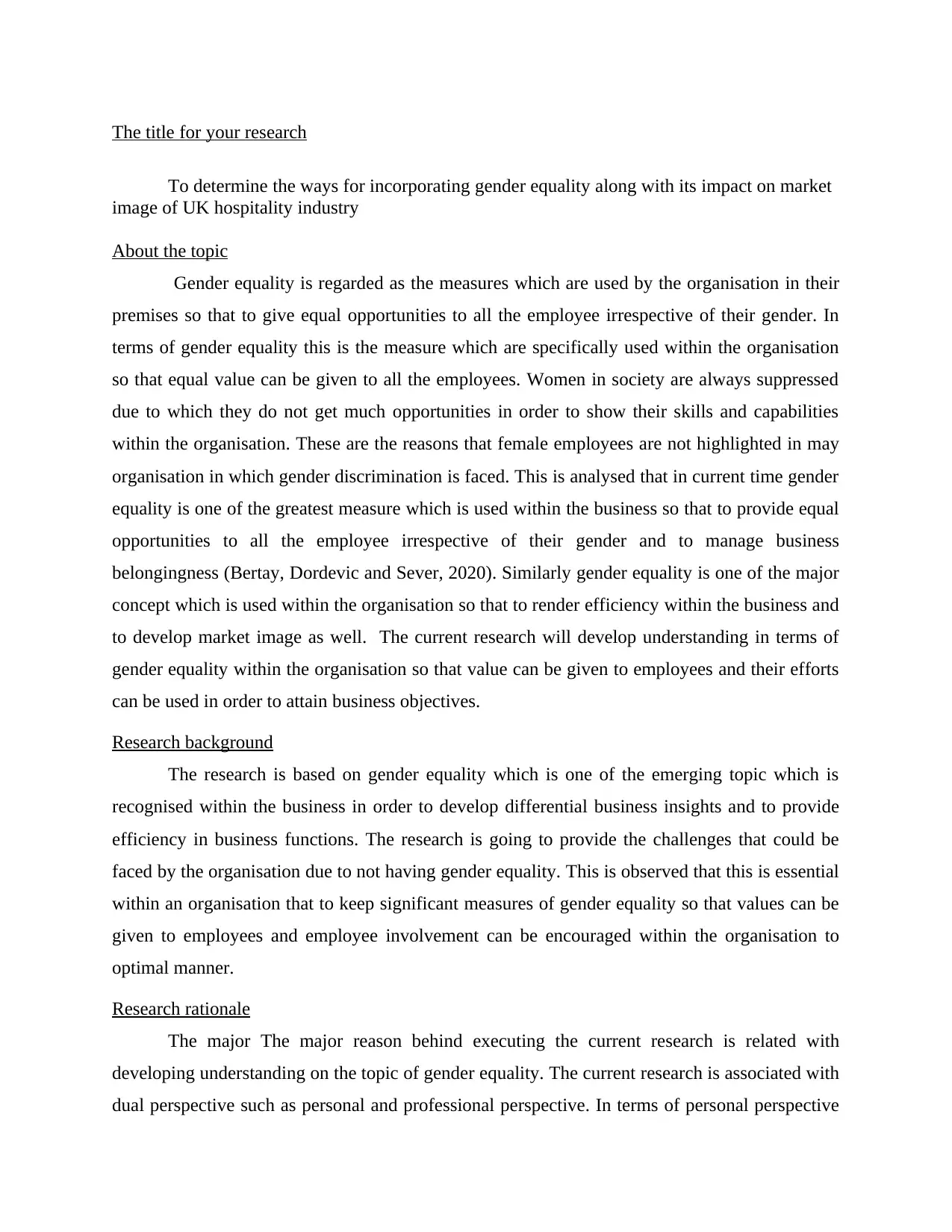
The title for your research
To determine the ways for incorporating gender equality along with its impact on market
image of UK hospitality industry
About the topic
Gender equality is regarded as the measures which are used by the organisation in their
premises so that to give equal opportunities to all the employee irrespective of their gender. In
terms of gender equality this is the measure which are specifically used within the organisation
so that equal value can be given to all the employees. Women in society are always suppressed
due to which they do not get much opportunities in order to show their skills and capabilities
within the organisation. These are the reasons that female employees are not highlighted in may
organisation in which gender discrimination is faced. This is analysed that in current time gender
equality is one of the greatest measure which is used within the business so that to provide equal
opportunities to all the employee irrespective of their gender and to manage business
belongingness (Bertay, Dordevic and Sever, 2020). Similarly gender equality is one of the major
concept which is used within the organisation so that to render efficiency within the business and
to develop market image as well. The current research will develop understanding in terms of
gender equality within the organisation so that value can be given to employees and their efforts
can be used in order to attain business objectives.
Research background
The research is based on gender equality which is one of the emerging topic which is
recognised within the business in order to develop differential business insights and to provide
efficiency in business functions. The research is going to provide the challenges that could be
faced by the organisation due to not having gender equality. This is observed that this is essential
within an organisation that to keep significant measures of gender equality so that values can be
given to employees and employee involvement can be encouraged within the organisation to
optimal manner.
Research rationale
The major The major reason behind executing the current research is related with
developing understanding on the topic of gender equality. The current research is associated with
dual perspective such as personal and professional perspective. In terms of personal perspective
To determine the ways for incorporating gender equality along with its impact on market
image of UK hospitality industry
About the topic
Gender equality is regarded as the measures which are used by the organisation in their
premises so that to give equal opportunities to all the employee irrespective of their gender. In
terms of gender equality this is the measure which are specifically used within the organisation
so that equal value can be given to all the employees. Women in society are always suppressed
due to which they do not get much opportunities in order to show their skills and capabilities
within the organisation. These are the reasons that female employees are not highlighted in may
organisation in which gender discrimination is faced. This is analysed that in current time gender
equality is one of the greatest measure which is used within the business so that to provide equal
opportunities to all the employee irrespective of their gender and to manage business
belongingness (Bertay, Dordevic and Sever, 2020). Similarly gender equality is one of the major
concept which is used within the organisation so that to render efficiency within the business and
to develop market image as well. The current research will develop understanding in terms of
gender equality within the organisation so that value can be given to employees and their efforts
can be used in order to attain business objectives.
Research background
The research is based on gender equality which is one of the emerging topic which is
recognised within the business in order to develop differential business insights and to provide
efficiency in business functions. The research is going to provide the challenges that could be
faced by the organisation due to not having gender equality. This is observed that this is essential
within an organisation that to keep significant measures of gender equality so that values can be
given to employees and employee involvement can be encouraged within the organisation to
optimal manner.
Research rationale
The major The major reason behind executing the current research is related with
developing understanding on the topic of gender equality. The current research is associated with
dual perspective such as personal and professional perspective. In terms of personal perspective
⊘ This is a preview!⊘
Do you want full access?
Subscribe today to unlock all pages.

Trusted by 1+ million students worldwide
1 out of 20
Related Documents
Your All-in-One AI-Powered Toolkit for Academic Success.
+13062052269
info@desklib.com
Available 24*7 on WhatsApp / Email
![[object Object]](/_next/static/media/star-bottom.7253800d.svg)
Unlock your academic potential
Copyright © 2020–2025 A2Z Services. All Rights Reserved. Developed and managed by ZUCOL.





